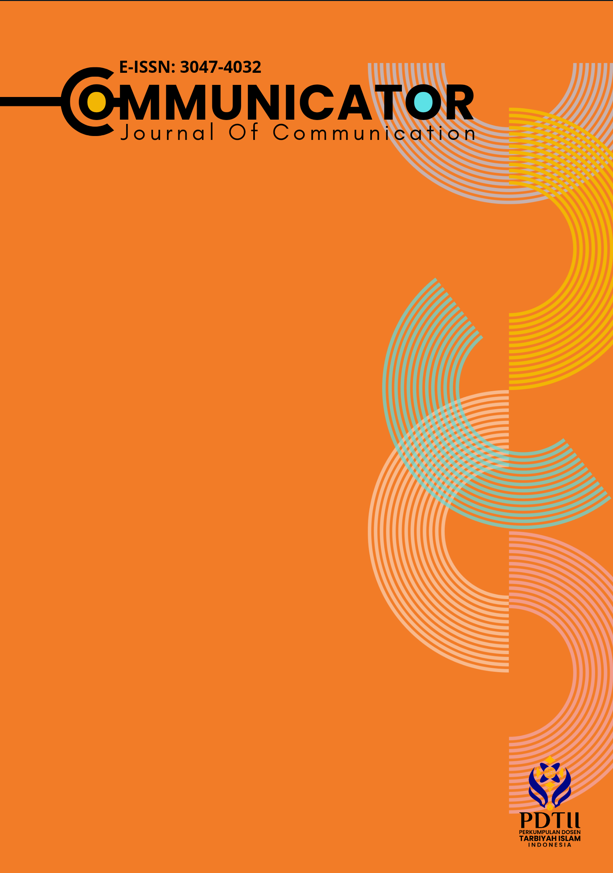Representation of Feminism in the Film Hati Suhita : Islamic Perspective
DOI:
https://doi.org/10.59373/comm.v2i1.99Keywords:
Feminisme, John Fiske's Semiotics, Hati Suhita Film, Women's RepresentationAbstract
This study aims to analyze the representation of feminism in the film Hati Suhita from an Islamic perspective using John Fiske's semiotic model. As a cinematic work that explores the themes of women, religion, and culture, Hati Suhita presents the complexity of women's roles within both domestic and public spheres. John Fiske's semiotic theory is employed to deconstruct the meanings embedded within the film's visual and narrative symbols through three levels of coding: reality, representation, and ideology. This qualitative research analyzes 36 selected scenes (screenshots) examined in depth. The findings reveal that the film portrays female characters, especially Alina Suhita, as representations of devout yet resilient and empowered Muslim women. She is depicted not only as obedient in the domestic sphere but also as a capable leader who actively contributes to the social realm through her involvement in managing a pesantren (Islamic boarding school). Feminist values such as independence, perseverance, female solidarity, and resistance to gender injustice are presented in the film without disregarding Islamic principles. At the ideological level, the film subtly critiques patriarchal norms embedded in society through a soft and religious lens. In conclusion, Hati Suhita successfully represents feminism within an Islamic framework by employing strong, symbolically rich cinematic elements with a spiritual tone. These findings significantly contribute to studying media, gender, and Islam in Indonesian culture.
Downloads
References
Adisaputro, S. E., & Sutamaji, S. (2021). DA'WAH STRATEGY IN SOCIAL MEDIA. Al-Tsiqoh: Journal of Islamic Economics and Da'wah, 6(1), Article 1. https://doi.org/10.31538/altsiq.v6i1.1262
Anggoro, M., Claudya, S., & Hardiyarso, S. (2024). Analysis of Relationship Assumptions: Experiencing Progress in Family Communication Patterns in the Korean Drama The Good Bad Mother 2023. PIKMA Journal: Publication of Media and Cinema Communication Science, 6(2), Article 2. https://doi.org/10.24076/pikma.v6i2.1505
Fatikh, M. A., & Hendrik, W. (2023). ISLAMIC CULTURAL AND CULTURAL COMMUNICATION. Al-Tsiqoh: Journal of Islamic Economics and Da'wah, 7(2), 48–61. https://doi.org/10.31538/altsiq.v7i2.3301
Fatima, N., & Fauziyah. (2024). The Message Of Da'wah In Films And Criticism Of The Concept Of Reincarnation. Communicator: Journal of Communication, 1(2), Article 2. https://doi.org/10.59373/comm.v1i2.68
Hakim, L., & Anjani, E. (2022). Representation of Gus Dur's Message of Peace About Papua in Mamat Alkatiri's Stand Up Comedy. Tribakti: Journal of Islamic Thought, 33(1), Article 1. https://doi.org/10.33367/tribakti.v33i1.1856
Harahap, N. Y. A., Harahap, N., & Abidin, S. (2023). JOHN FISKE'S SEMIOTIC ANALYSIS of GENDER INEQUALITY IN THE 2016 DANGAL FILM. SIBATIK JOURNAL: Scientific Journal of Social, Economic, Cultural, Technological, and Educational, 2(4), Article 4. https://doi.org/10.54443/sibatik.v2i4.725
Infortuna, C., Battaglia, F., Freedberg, D., Mento, C., Zoccali, R. A., Muscatello, M. R. A., & Bruno, A. (2021). The inner muses: How affective temperament traits, gender, and age predict film genre preference. Personality and Individual Differences, 178, 110877. https://doi.org/10.1016/j.paid.2021.110877
Jauza, M. H., & Walisyah, T. (2024). SEMIOTIC ANALYSIS OF DA'WAH MESSAGES IN THE FILM TEARS AT THE END OF THE PRAYER MAT 2023 BY RONNY IRAWAN. Journal of Communication Sciences UHO: Journal of Research on Communication and Information Sciences, 9(3), Article 3. https://doi.org/10.52423/jikuho.v9i3.236
Khairunniza, L. D. E., Handani, S. S., Mustika, D., & Haryani, Y. (2024). Analysis of Gender Representation in The Main Characters of The Film Barbie 2023: A Social Science Educational Perspective. Edueksos Journal of Social & Economic Education, 13(01), Article 01. https://doi.org/10.24235/edueksos.v13i01.15607
Mubarok, A. (2020). THE MESSAGE OF DA'WAH IN THE FILM THERE IS HEAVEN IN YOUR HOUSE. Al-Tsiqoh: Journal of Islamic Economics and Da'wah, 5(2), Article 2. https://doi.org/10.31538/altsiq.v5i2.881
Natalia, W., & Nurul, W. (2021). ANALYSIS OF ROLAND BARTHES' SEMIOTICS IN THE MUSIC VIDEO BTS INTERLUDE: SHADOW AND OUTRO: EGO. Al-Tsiqoh: Journal of Islamic Economics and Da'wah, 6(2), Article 2. https://doi.org/10.31538/altsiq.v6i2.2083
Paramita, S., & Chaniago, A. (2018). REPRESENTATION OF TOMBOY IDENTITY IN THE MOVIE INSIDE OUT. SEMIOTICS: Journal of Communication, 11(2), Article 2. https://doi.org/10.30813/s:jk.v11i2.1169
Pardede, I. F., Perwirawati, E., & Pinem, S. H. (2022). SEMIOTIC ANALYSIS OF MORAL MESSAGES IN KOREAN DRAMA "ITAEWON CLASS". JOURNAL OF SOCIAL OPINION: Scientific Journal of Communication Sciences, 6(2), Article 2.
Priyadharshini, J., & Karthiga, R. K. J. (2025). The biopsychosocial materno-semiotics framework: A holistic analytical tool for film studies. Methods X, 14, 103279. https://doi.org/10.1016/j.mex.2025.103279
Puspitasari, D. R. (2021). SOCIO-CULTURAL VALUES IN FILM TILIK (A STUDY OF CHARLES SANDERS PIERCE'S SEMIOTICS). SEMIOTICS: Journal of Communication, 15(1), Article 1. https://doi.org/10.30813/s:jk.v15i1.2494
Downloads
Published
How to Cite
Issue
Section
License
Copyright (c) 2025 Communicator: Journal of Communication

This work is licensed under a Creative Commons Attribution-ShareAlike 4.0 International License.







